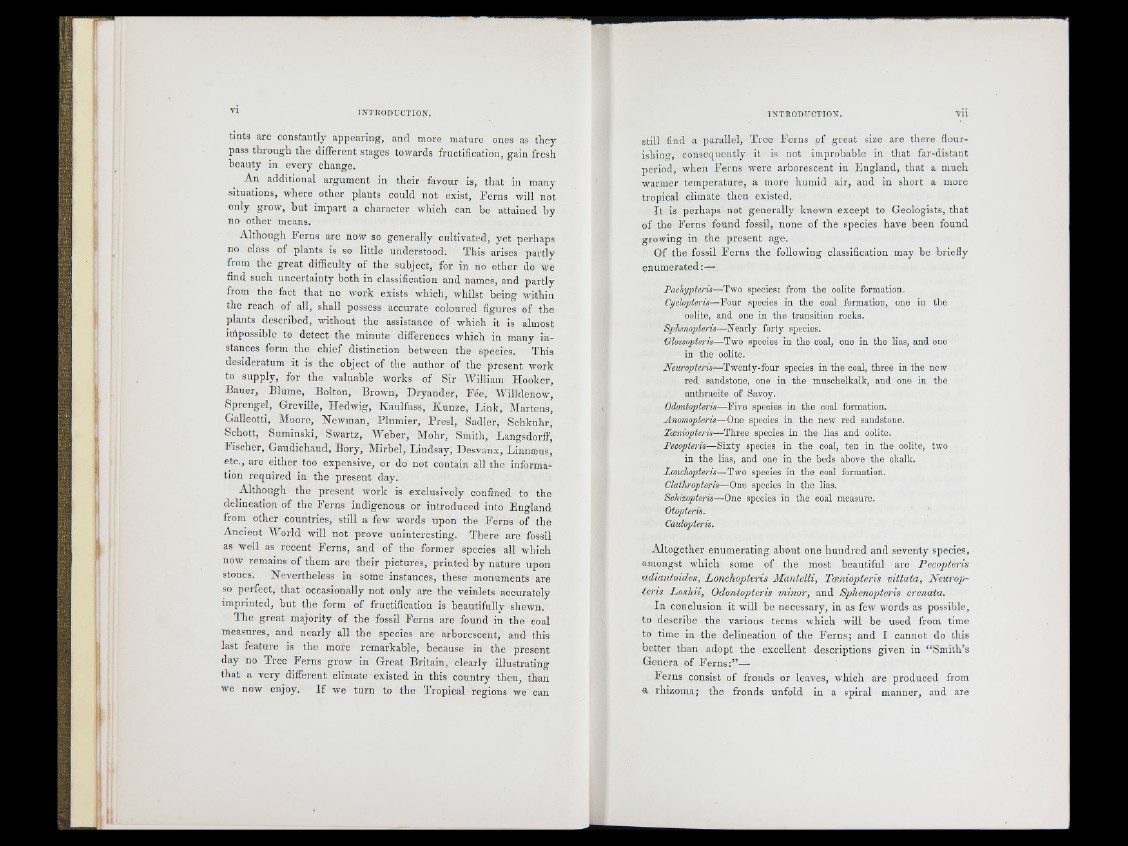
tints are constantly appearing, and more mature ones as they
pass through the different stages towards fructification, gain fresh
beauty in every change.
An additional argument in their favour is, that in many
situations, where other plants could not exist. F erns will not
only grow, b u t impart a character which can be attained by
no other means.
Although Ferns are now so generally cultivated, yet perhaps
no class of plants is so little understood. This arises partly
from the gre a t difficulty of the subject, for in no other do we
find such uncertainty both in classification and names, and pa rtly
from the fact that no work exists which, whilst being within
the reach of all, shall possess accurate coloured figures of the
plants described, without the assistance of which it is almost
inipossible to detect the minute differences which in many in stances
form the chief distinction between the species. This
desideratum it is the object of the author of the present work
to supply, for the valuable works of Sir William Hooker,
Bauer, Blume, Bolton, Brown, Dry an d e r, Fée, Willdenow,
Sprengel, Greville, Hedwig, Kaulfuss, Kun z e , L in k , Martens,
Galleotti, Moore, Newman, Plum ie r, P re sl, Sadler, Sohkuhr,
Schott, Siiminski, Swartz, W eb e r, Mohr, Smith, LangsdorfF,
lis c h e r, Gaudichaud, Bory, Mlrbel, Lindsay, Desvaux, Linnæus,
etc., are either too expensive, or do not contain all the information
req u ired in the present day.
Although the present work is exclusively confined to the
delineation of the F erns Indigenous or introduc ed into E ngland
from other countries, still a few words upon the F erns of the
Ancient W o rld will not prove uninteresting. T here are fossil
as well as recent F e rn s, and of the former species all which
now remains of them are their pictures, p rin ted by nature upon
stones. Nevertheless in some instances, these monuments are
so perfect, th a t occasionally not only are the veinlets accurately
imprinted, b u t the form of fructification is beautifully shewn.
The gre a t majority of the fossil F e rn s are found in the coal
measures, and nearly all the species are arborescent, and this
last feature is the more remarkable, because in the present
day no Tree F erns grow in Great Britain, clearly illustrating
that a very different climate existed in this country then, than
we now enjoy. I f we tu rn to the Tropical regions we can
still find a parallel, Tree Ferns of great size are there flourishing,
consequently it is not improbable in th a t far-distant
period, when F erns were arborescent in E ngland, that a much
warmer temperature, a more humid air, and in short a more
tropical climate then existed.
I t is perhaps not generally known except to Geologists, that
of the F erns found fossil, none of the species have been found
growing in the present age.
Of the fossil F erns the following classification may be briefly
enumerated:—
Pachypteris—Two species; from the oolite formation.
Cyclopteris—Four species in the coal formation, one in the
oolite, and one in the transition rocks.
Sphenopteris—Nearly forty species.
Glossopteris—Two species in the coal, one in the lias, and one
in the oolite.
WiirajDfom—Twenty-four species in the coal, three in the new
red sandstone, one in the muschelkalk, and one in the
anthracite of Savoj^.
Odontopteris—Five species in the coal formation.
AnomopUris—One species in the new red sandstone.
Tisniopteris—Three species in the lias and oolite.
Pecopteris—Sixty species in the coal, ten in the oolite, two
in the lias, and one in the beds above the chalk.
Lonchopteris—Two species in the coal formation.
Clathropteris—One species in the lias.
Schi%opteris—One species in the coal measure.
Otopteris.
Altogether enumerating about one hu n d red and seventy species,
amongst which some of the most beautiful are Pecopteris
adiantoides, Lonchoptcris Mantelli, Tocniopteris vittata, Neurop-
teris Losld i, Odontopteris minor, and Sphenopteris crenata.
In conclusion it will be necessary, in as few words as possible,
to describe the various terms which will be used from time
to time in the delineation of the F e rn s; and I cannot do this
b etter than adopt the excellent descriptions given in “ Smith’s
Genera of F e rn s ;”—
F e rn s consist of fronds or leaves, which are produced from
a rhizoma; the fronds unfold in a spiral manner, and are